Waste Management of Red Mud and Fly Ash to Utilize in Road Subgrade Material
Abstract
:1. Introduction
2. Materials and Methods
2.1. Materials
2.1.1. Red Mud
2.1.2. Fly Ash
2.2. Methodology
3. Results and Discussions
3.1. Atterberg Limits
3.2. Compaction Characteristics
3.3. Density
3.4. Unconfined Compressive Strength (UCS) Characteristics
3.5. California Bearing Ratio (CBR)
3.6. SEM Characteristics
4. Conclusions
- The lower density of fly ash compared to red mud, along with its finer particles, leads to an increase in plastic properties and optimum water content in the improved samples. However, it also results in a decrease in maximum dry density.
- The addition of fly ash to the red mud has increased the UCS strength. During the curing period, pozzolanic reactions took place, leading to a significant increase in the improvement percentage.
- According to the results of the wet CBR test, the CBR value for the red mud sample improved with 25% fly ash and cured for 28 days was found to be 268.25%. This value is more than sufficient for road fill material.
Author Contributions
Funding
Institutional Review Board Statement
Informed Consent Statement
Data Availability Statement
Conflicts of Interest
References
- Kumar, S.; Kumar, R.; Bandopadhyay, A. Innovative methodologies for the utilisation of wastes from metallurgical and allied industries. Resour. Conserv. Recycl. 2006, 48, 301–314. [Google Scholar] [CrossRef]
- Yang, Y.; Wang, X.; Wang, M.; Wang, H.; Xian, P. Iron recovery from the leached solution of red mud through the application of oxalic acid. Int. J. Miner. Process. 2016, 157, 145–151. [Google Scholar] [CrossRef]
- Hooda, A.; Malik, P.; Sangwan, V. Research paper on gauging engineering properties of red mud-fly ash-marble dust amalgamation. Int. J. All Res. Educ. Sci. Methods 2016, 5, 252–258. [Google Scholar]
- Kehagia, F. A successful pilot project demonstrating the re-use potential of bauxite residue in embankment construction. Resour. Conserv. Recycl. 2010, 54, 417–421. [Google Scholar] [CrossRef]
- Li, L.Y. Properties of red mud tailings produced under varying process conditions. J. Environ. Eng. 1998, 124, 254–264. [Google Scholar] [CrossRef]
- Newson, T.; Dyer, T.; Adam, C.; Sharp, S. Effect of structure on the geotechnical properties of bauxite residue. J. Geotech. Geoenviron. Eng. 2006, 132, 143–151. [Google Scholar] [CrossRef]
- Power, G.; Gräfe, M.; Klauber, C. Bauxite residue issues: I. Current management, disposal and storage practices. Hydrometallurgy 2011, 108, 33–45. [Google Scholar] [CrossRef]
- Silveira, N.C.G.; Martins, M.L.F.; Bezerra, A.C.S.; Araújo, F.G.S. Red mud from the aluminium industry: Production, characteristics, and alternative applications in construction materials—A review. Sustainability 2021, 13, 12741. [Google Scholar] [CrossRef]
- U.S. Geological Survey. Mineral Commodity Summaries 2022; USGS: Reston, Virginia, 2022.
- Tsakiridis, P.E.; Agatzini-Leonardou, S.; Oustadakis, P. Red mud addition in the raw meal for the production of Portland cement clinker. J. Hazard. Mater. 2004, 116, 103–110. [Google Scholar] [CrossRef]
- Liu, W.; Chen, X.; Li, W.; Yu, Y.; Yan, K. Environmental assessment, management and utilization of red mud in China. J. Clean. Prod. 2014, 84, 606–610. [Google Scholar] [CrossRef]
- Kalkan, E. Utilization of red mud as a stabilization material for the preparation of clay liners. Eng. Geol. 2006, 87, 220–229. [Google Scholar] [CrossRef]
- Balomenos, E.; Gianopoulou, I.; Panias, D.; Paspaliaris, I. A novel red mud treatment process: Process design and preliminary results. Travaux ICSOBA 2011, 36, 255–266. [Google Scholar]
- Deelwal, K.; Dharavath, K.; Kulshreshtha, M. Evaluation of characteristic properties of red mud for possible use as a geotechnical material in civil construction. Int. J. Adv. Eng. Technol. 2014, 7, 1053. [Google Scholar]
- Mukiza, E.; Liu, X.; Zhang, L.; Zhang, N. Preparation and characterization of a red mud-based road base material: Strength formation mechanism and leaching characteristics. Constr. Build. Mater. 2019, 220, 297–307. [Google Scholar] [CrossRef]
- Gelencsér, A.; Kováts, N.; Turóczi, B.; Rostási, Á.; Hoffer, A.; Imre, K.; Nyirő-Kósa, I.; Csákberényi-Malasics, D.; Tóth, Á.; Czitrovszky, A.; et al. The red mud accident in Ajka (Hungary): Characterization and potential health effects of fugitive dust. Environ. Sci. Technol. 2011, 45, 1608–1615. [Google Scholar] [CrossRef] [PubMed]
- Ruyters, S.; Mertens, J.; Vassilieva, E.; Dehandschutter, B.; Poffijn, A.; Smolders, E. The red mud accident in Ajka (Hungary): Plant toxicity and trace metal bioavailability in red mud contaminated soil. Environ. Sci. Technol. 2011, 45, 1616–1622. [Google Scholar] [CrossRef] [PubMed]
- Alves, L. Toxic water seeps from Norwegian mining site in Brazil’s Amazon. The Rio Times, 2018. Available online: https://www.riotimesonline.com/brazil-news/rio-politics/toxic-water-seeps-from-norwegian-mining-site-in-brazils-amazon/ (accessed on 2 February 2024).
- Kuntikana, G.; Singh, D.N. Contemporary issues related to utilization of industrial byproducts. Adv. Civ. Eng. Mater. 2017, 6, 444–479. [Google Scholar] [CrossRef]
- Kong, X.; Guo, Y.; Xue, S.; Hartley, W.; Wu, C.; Ye, Y.; Cheng, Q. Natural evolution of alkaline characteristics in bauxite residue. J. Clean. Prod. 2017, 143, 224–230. [Google Scholar] [CrossRef]
- Hua, Y.; Heal, K.V.; Friesl-Hanl, W. The use of red mud as an immobiliser for metal/metalloid-contaminated soil: A review. J. Hazard. Mater. 2017, 325, 17–30. [Google Scholar] [CrossRef] [PubMed]
- Dodoo-Arhin, D.; Nuamah, R.A.; Agyei-Tuffour, B.; Obada, D.O.; Yaya, A. Awaso bauxite red mud-cement based composites: Characterisation for pavement applications. Case Stud. Constr. Mater. 2017, 7, 45–55. [Google Scholar] [CrossRef]
- Metecan, I.H.; Karayildirim, T.; Yanik, J.; Saglam, M.; Yuksel, M. The effect of sulfur-promoted red mud catalysts on hydroliquefaction of oil shale. Oil Shale 2003, 20, 69–79. [Google Scholar] [CrossRef]
- Mastral, A.; Mayoral, C.; Izquierdo, M.; Pardos, C. Iron-catalyzed hydrogenation of high-sulfur content coals. Fuel Process. Technol. 1993, 36, 177–184. [Google Scholar] [CrossRef]
- Yokoyama, S.; Yamamoto, M.; Maekawa, Y.; Kotanigawa, T. Catalytic activity of sulphate for hydroliquefaction of coal by using diphenylether and diphenylmethane. Fuel 1989, 68, 531–533. [Google Scholar] [CrossRef]
- Vangelatos, I.; Angelopoulos, G.N.; Boufounos, D. Utilization of ferroalumina as raw material in the production of Ordinary Portland Cement. J. Hazard. Mater. 2009, 168, 473–478. [Google Scholar] [CrossRef] [PubMed]
- Tang, W.C.; Wang, Z.; Liu, Y.; Cui, H.Z. Influence of red mud on fresh and hardened properties of self-compacting concrete. Constr. Build. Mater. 2018, 178, 288–300. [Google Scholar] [CrossRef]
- Chen, Y.; Ke, Y.; Liang, S.; Hu, J.; Hou, H.; Yang, J. Enhanced bromine fixation and tar lightweighting in co-pyrolysis of non-metallic fractions of waste printed circuit boards with Bayer red mud. Waste Manag. 2023, 162, 72–82. [Google Scholar] [CrossRef] [PubMed]
- Kang, K.; Loebsack, G.; Sarchami, T.; Klinghoffer, N.B.; Papari, S.; Yeung, K.K.-C.; Berruti, F. Production of a bio-magnetic adsorbent via co-pyrolysis of pine wood waste and red mud. Waste Manag. 2022, 149, 124–133. [Google Scholar] [CrossRef] [PubMed]
- Li, Y.; Min, X.; Ke, Y.; Liu, D.; Tang, C. Preparation of red mud-based geopolymer materials from MSWI fly ash and red mud by mechanical activation. Waste Manag. 2019, 83, 202–208. [Google Scholar] [CrossRef] [PubMed]
- Occhicone, A.; Vukčević, M.; Bosković, I.; Ferone, C. Red Mud-Blast Furnace Slag-Based Alkali-Activated Materials. Sustainability 2021, 13, 11298. [Google Scholar] [CrossRef]
- Consoli, N.C.; Párraga Morales, D.; Saldanha, R.B. A new approach for stabilization of lateritic soil with Portland cement and sand: Strength and durability. Acta Geotech. 2021, 16, 1473–1486. [Google Scholar] [CrossRef]
- Kulkarni, P.P.; Mandal, J.N. Strength evaluation of soil stabilized with nano silica- cement mixes as road construction material. Constr. Build. Mater. 2022, 314, 125363. [Google Scholar] [CrossRef]
- Raja, K.; Venkatachalam, S.; Vishnuvardhan, K.; Siva Rama Krishnan, R.; Tamil Selvan, V.; Vetriselvan, N. A review on soil stabilization using rice husk ash and lime sludge. Mater. Today Proc. 2022, 65, 1205–1212. [Google Scholar] [CrossRef]
- Andavan, S.; Pagadala, V.K. A study on soil stabilization by addition of fly ash and lime. Mater. Today Proc. 2020, 22, 1125–1129. [Google Scholar] [CrossRef]
- Karami, H.; Pooni, J.; Robert, D.; Costa, S.; Li, J.; Setunge, S. Use of secondary additives in fly ash based soil stabilization for soft subgrades. Transp. Geotech. 2021, 29, 100585. [Google Scholar] [CrossRef]
- Bulbul, S.; Ayhan, E.; Gökmeşe, H. Termik Santral Atığı Olan Kömür Külünün SBR Matrisli Bileşiklere İlave Edilmesinin Mekanik Özelliklere Etkisi. Necmettin Erbakan Üniversitesi Fen Ve Mühendislik Bilim. Derg. 2023, 5, 135–146. [Google Scholar]
- National Academies of Sciences E and M (NASEM). Recommended Practice for Stabilization of Subgrade Soils and Base Materials; The National Academies Press: Washington, DC, USA, 2009. [Google Scholar]
- Rao, C.; Naidu, P.G.; Satyanyarana, P.V.V.; Adiseshu, S. Application of GGBS stabilized red mud in road construction. IOSR J Eng. 2012, 2, 14–20. [Google Scholar]
- Ma, S.; Sun, Z.; Wei, J.; Zhang, X.; Zhang, L. Utilization of modified red mud waste from the bayer process as subgrade and its performance assessment in a large-sale application. Coatings 2022, 12, 471. [Google Scholar] [CrossRef]
- Chen, R.; Cai, G.; Dong, X.; Mi, D.; Puppala, A.J.; Duan, W. Mechanical properties and micro-mechanism of loess roadbed filling using by-product red mud as a partial alternative. Constr. Build. Mater. 2019, 216, 188–201. [Google Scholar] [CrossRef]
- Sahoo, S.; Mohanty, C. Construction of road sub-base by using industrial waste. Int. J. Eng. Res. Dev. 2016, 3, 20–26. [Google Scholar]
- Kushwaha, S.S.; Kishan, D. Stabilization of red mud by lime and gypsum and investigating its possible use in geoenvironmental engineering. In Proceedings of the Geo-Chicago 2016, Chicago, IL, USA, 14–18 August 2016; pp. 978–988. [Google Scholar]
- Sabat, A.K.; Mohanta, S. Efficacy of dolime fine stabilized red mud-fly ash mixes as subgrade material. ARPN J. Eng. Appl. Sci. 2015, 10, 5919–5923. [Google Scholar]
- Satayanarayana, P.V.V.; Naidu, G.; Adiseshu, S.; Rao, C. Characterization of lime stabilized red mud mix for feasibility in road construction. Int. J. Eng. Res. Dev. 2012, 3, 20–26. [Google Scholar]
- ASTM D2487; Standard Practice for Classification of Soils for Engineering Purposes (Unified Soil Classification System). ASTM International: West Conshohocken, PA, USA, 2017.
- Chen, C.R.; Phillips, I.R.; Wei, L.L.; Xu, Z.H. Behaviour and dynamics of di-ammonium phosphate in bauxite processing residue sand in Western Australia—I. NH3 volatilisation and residual nitrogen availability. Environ. Sci. Pollut. Res. 2010, 17, 1098–1109. [Google Scholar] [CrossRef] [PubMed]
- Santini, T.C.; Fey, M.V. Spontaneous Vegetation Encroachment upon Bauxite Residue (Red Mud) As an Indicator and Facilitator of In Situ Remediation Processes. Environ. Sci. Technol. 2013, 47, 12089–12096. [Google Scholar] [CrossRef] [PubMed]
- ASTM C618-17; Standard Specification for Coal Ash and Raw or Calcined Natural Pozzolan for Use in Concrete. ASTM International: West Conshohocken, PA, USA, 2018.
- ASTM C618-23; Standard Specification for Coal Ash and Raw or Calcined Natural Pozzolan for Use in Concrete. ASTM International: West Conshohocken, PA, USA, 2023.
- Zha, F.; Liu, S.; Du, Y.; Cui, K. Behavior of expansive soils stabilized with fly ash. Nat. Hazards 2008, 47, 509–523. [Google Scholar] [CrossRef]
- Yenginar, Y.; Olgun, M. Optimizing installation parameters of DM columns in clay using Taguchi method. Bull. Eng. Geol. Environ. 2023, 82, 145. [Google Scholar] [CrossRef]
- Yenginar, Y.; Olgun, M. Optimizing construction parameters of DMC in high plasticity soils. In Proceedings of the 8th Geotechnical Symposium, İstanbul, Turkey, 13–15 November 2019. [Google Scholar]
- ASTM D4318; Standard Test Methods for Liquid Limit, Plastic Limit, and Plasticity Index of Soils. ASTM International: West Conshohocken, PA, USA, 2017.
- ASTM D698-12; Standard Test Methods for Laboratory Compaction Characteristics of Soil Using Standard Effort (12,400 ft-lbf/ft3 (600 kN-m/m3)) [Internet]. ASTM International: West Conshohocken, PA, USA, 2021.
- ASTM D2166; Standard Test Method for Unconfined Compressive Strength of Cohesive Soil. ASTM International: West Conshohocken, PA, USA, 2016.
- ASTM D1883-21; Standard Test Method for California Bearing Ratio (CBR) of Laboratory-Compacted Soils. ASTM International: West Conshohocken, PA, USA, 2021.
- Sarath Chandra, K.; Krishnaiah, S. Strength and leaching characteristics of red mud (bauxite residue) as a geomaterial in synergy with fly ash and gypsum. Transp. Res. Interdiscip. Perspect. 2022, 13, 100566. [Google Scholar] [CrossRef]
- HTS. Highway Technical Specification; General Directorate of Highways: Ankara, Turkey, 2013. [Google Scholar]
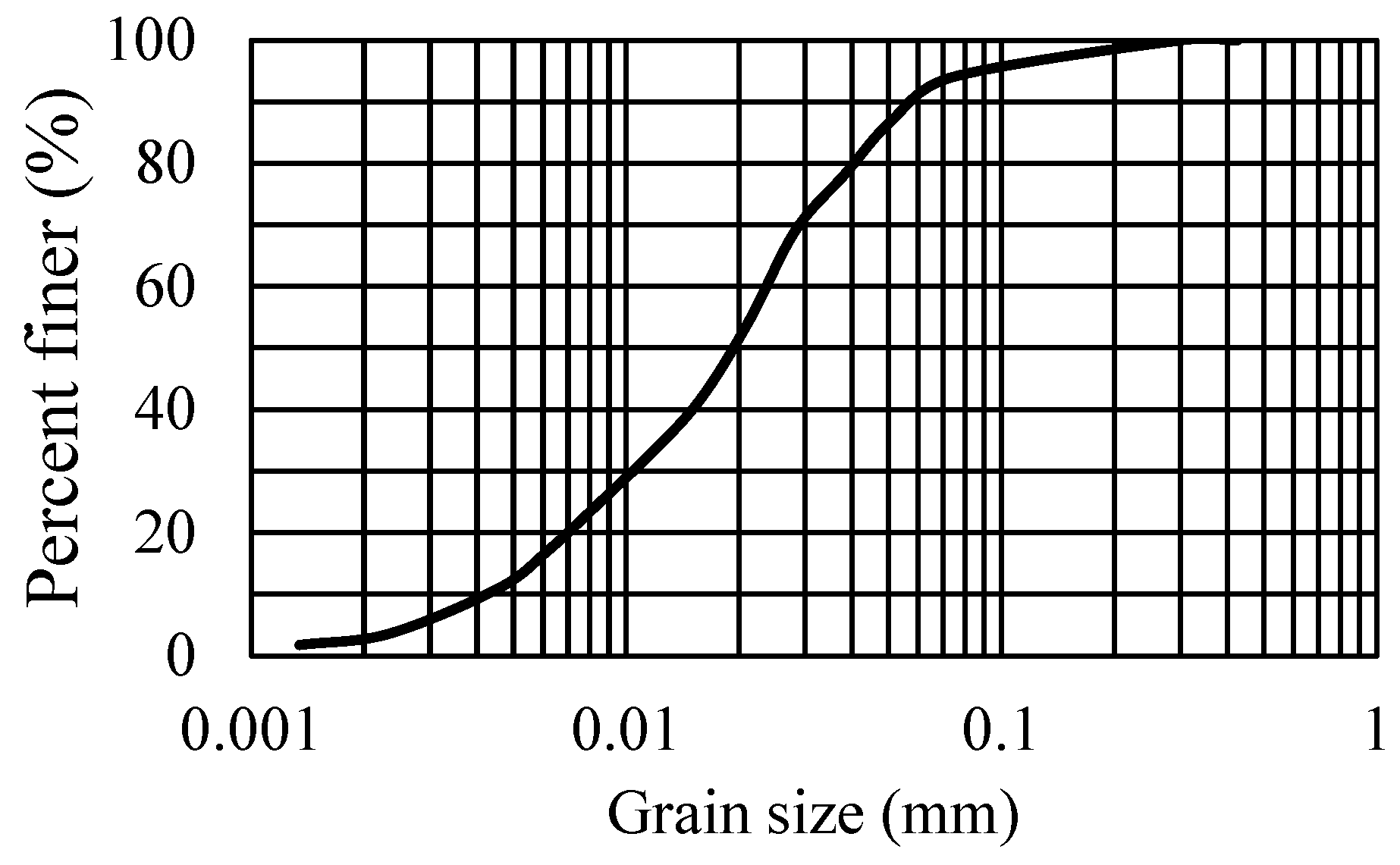


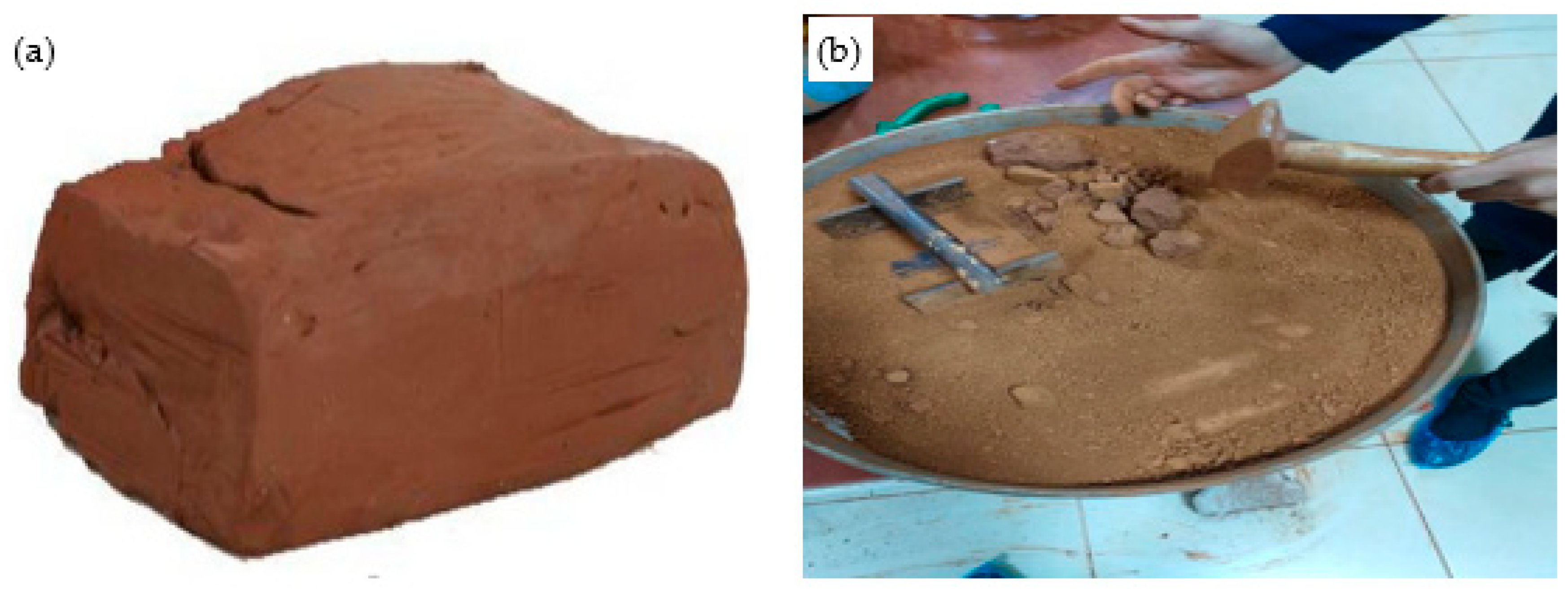
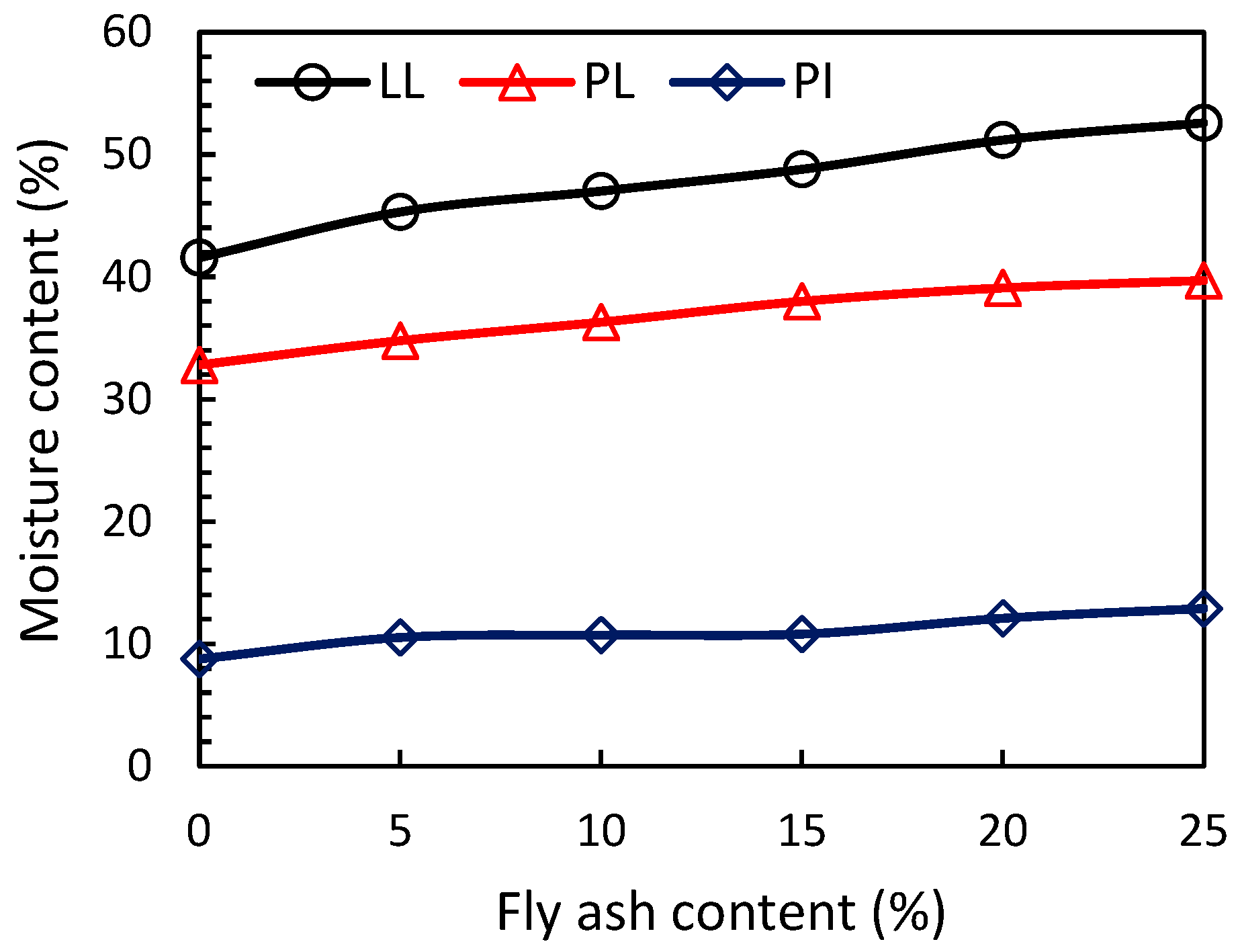
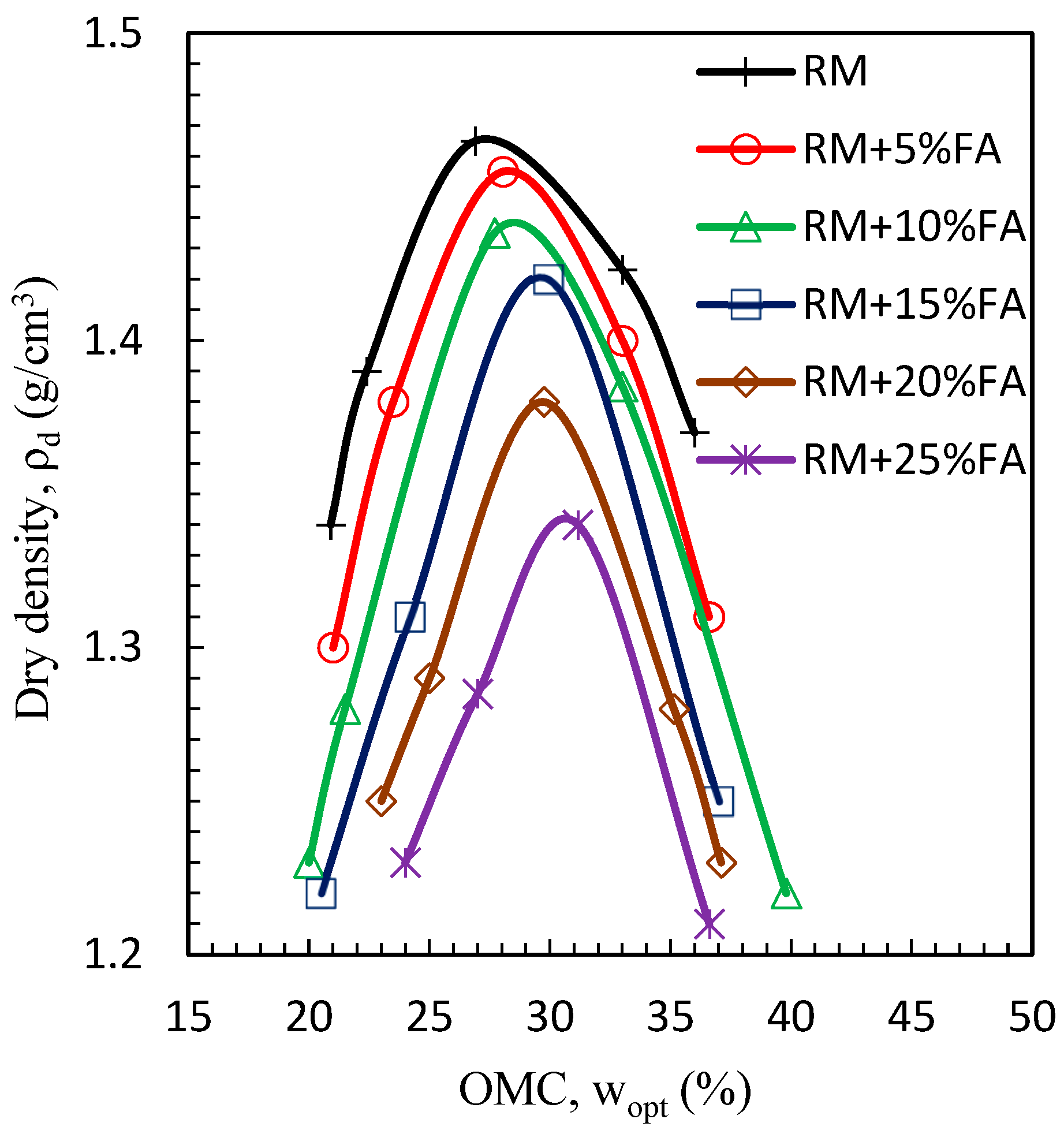
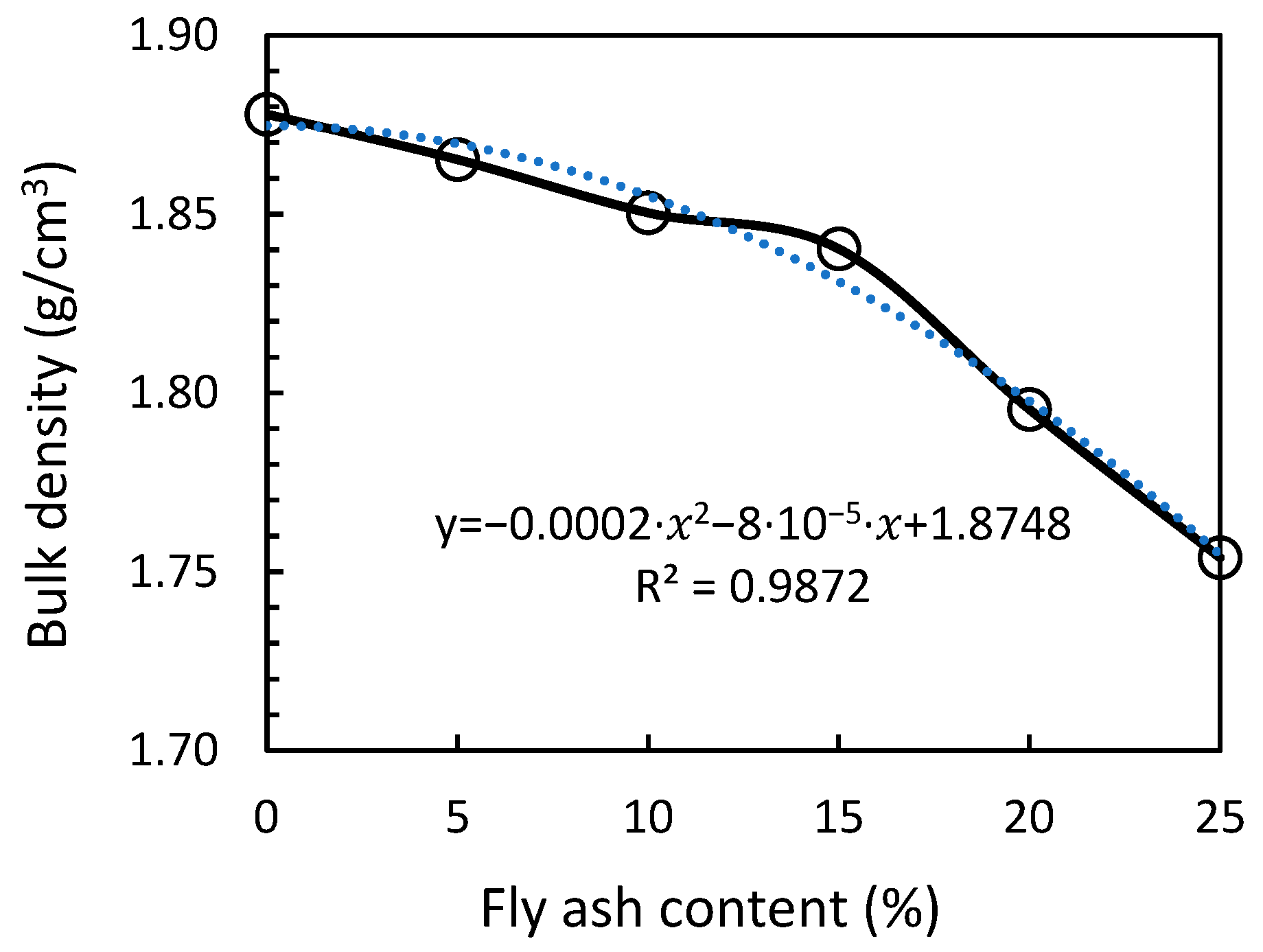

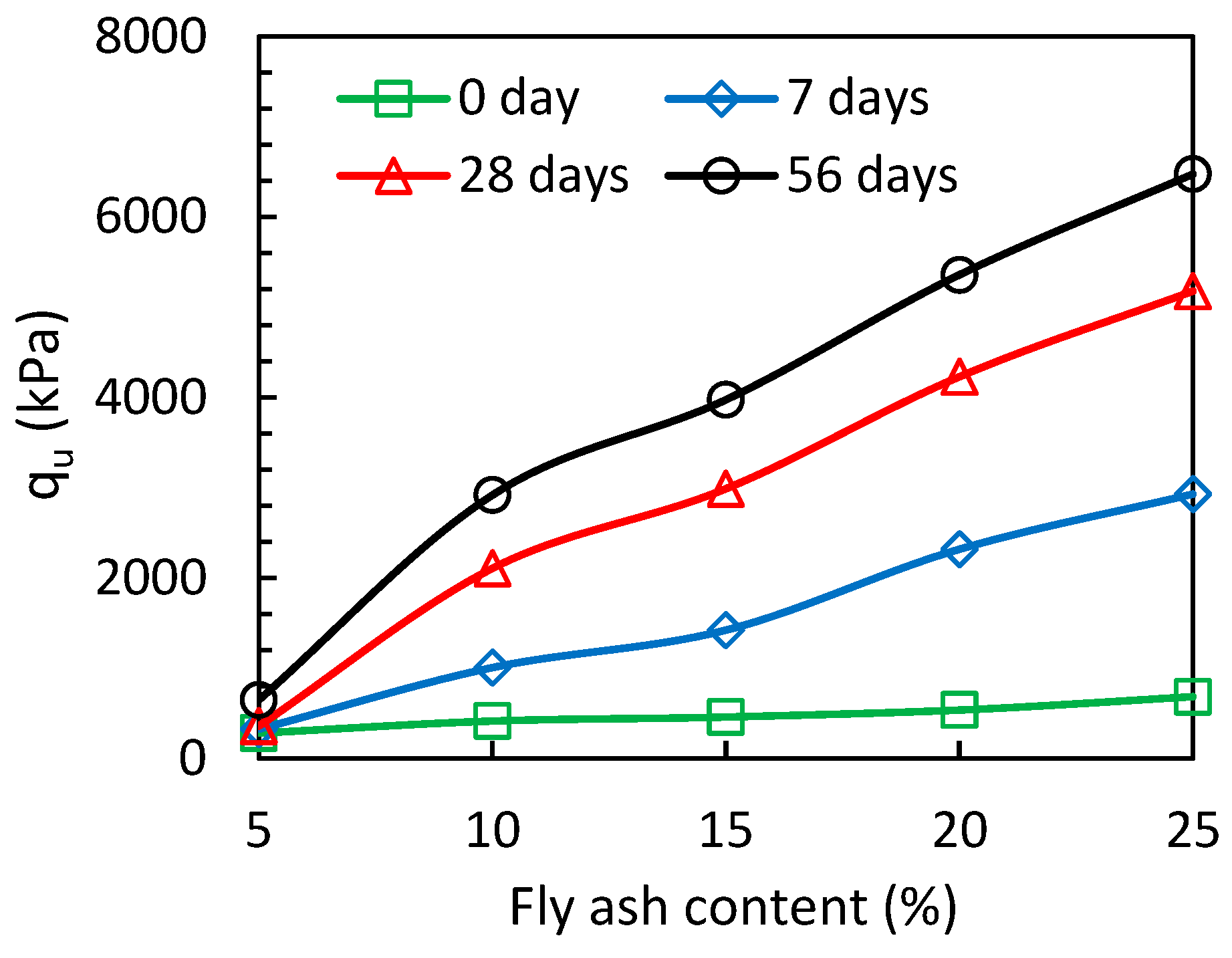
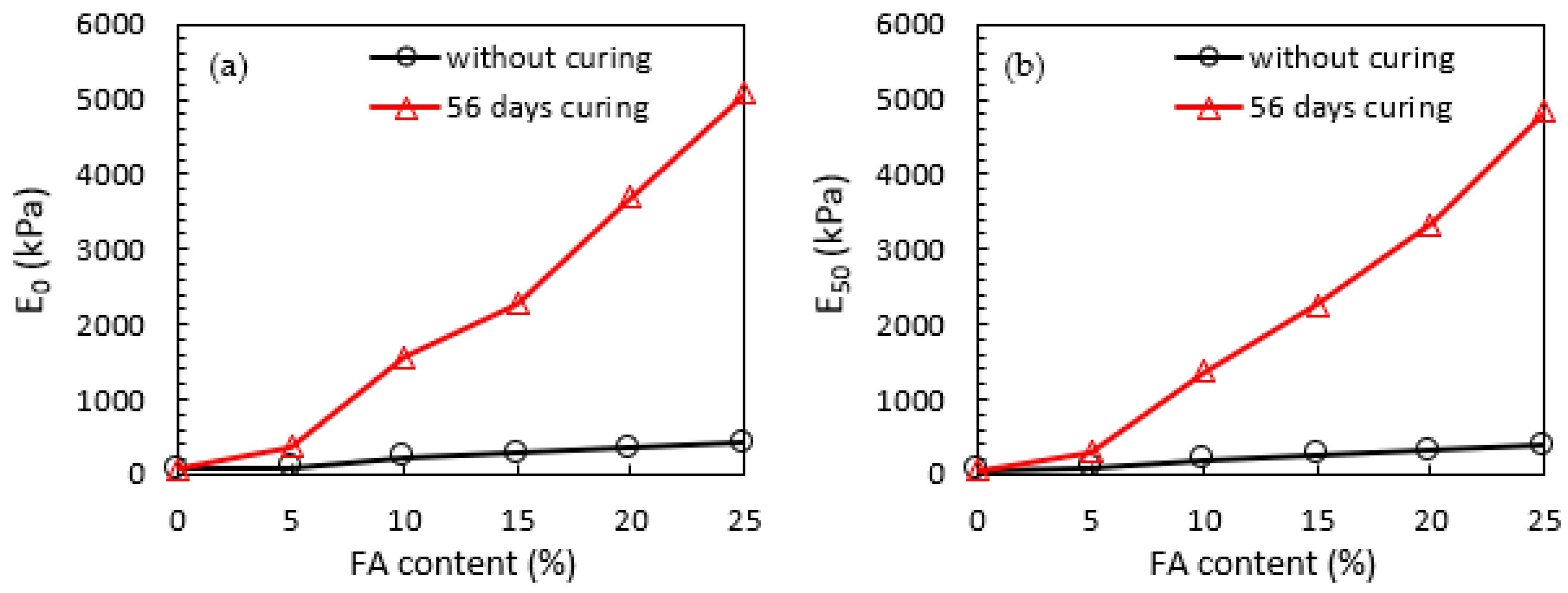
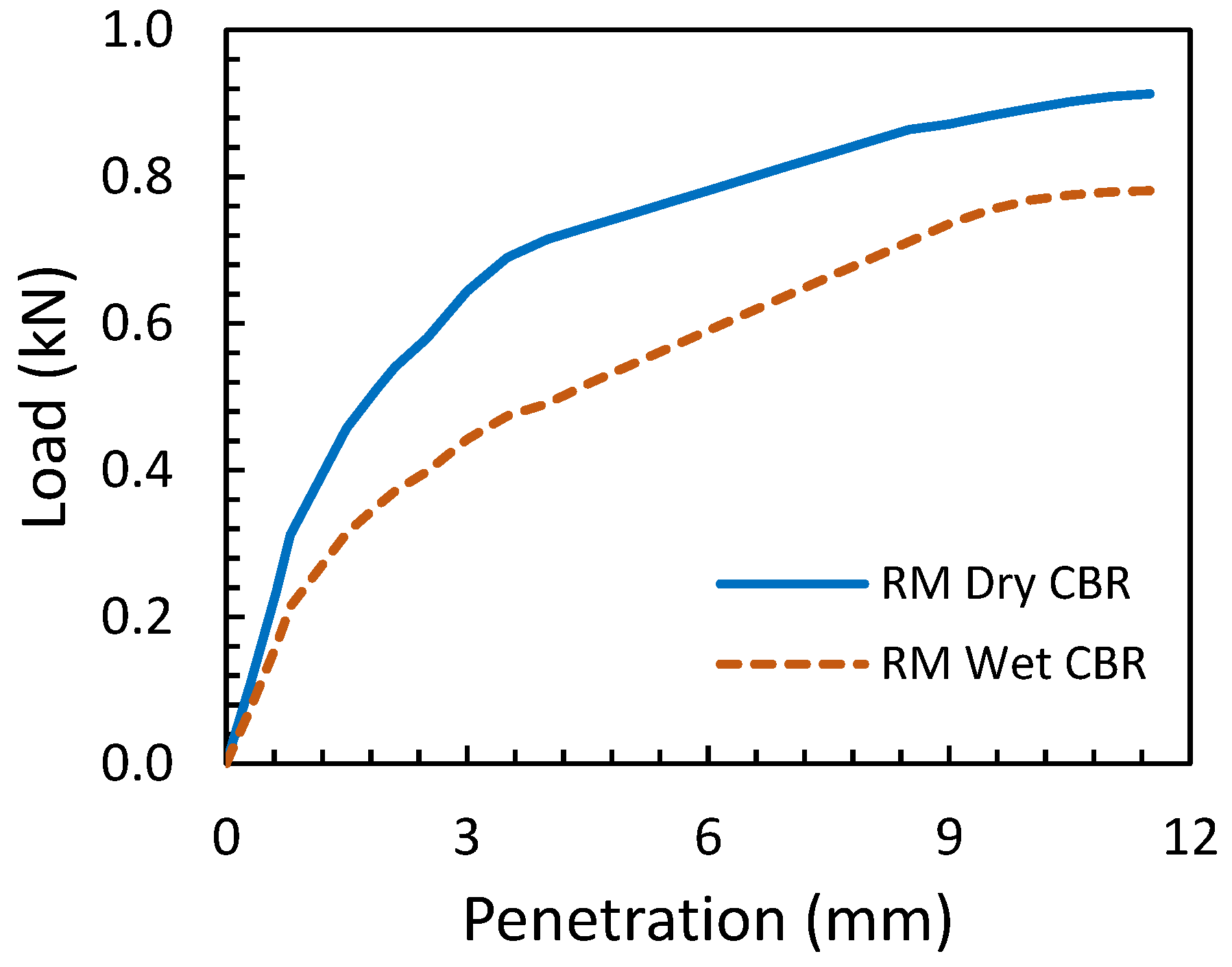
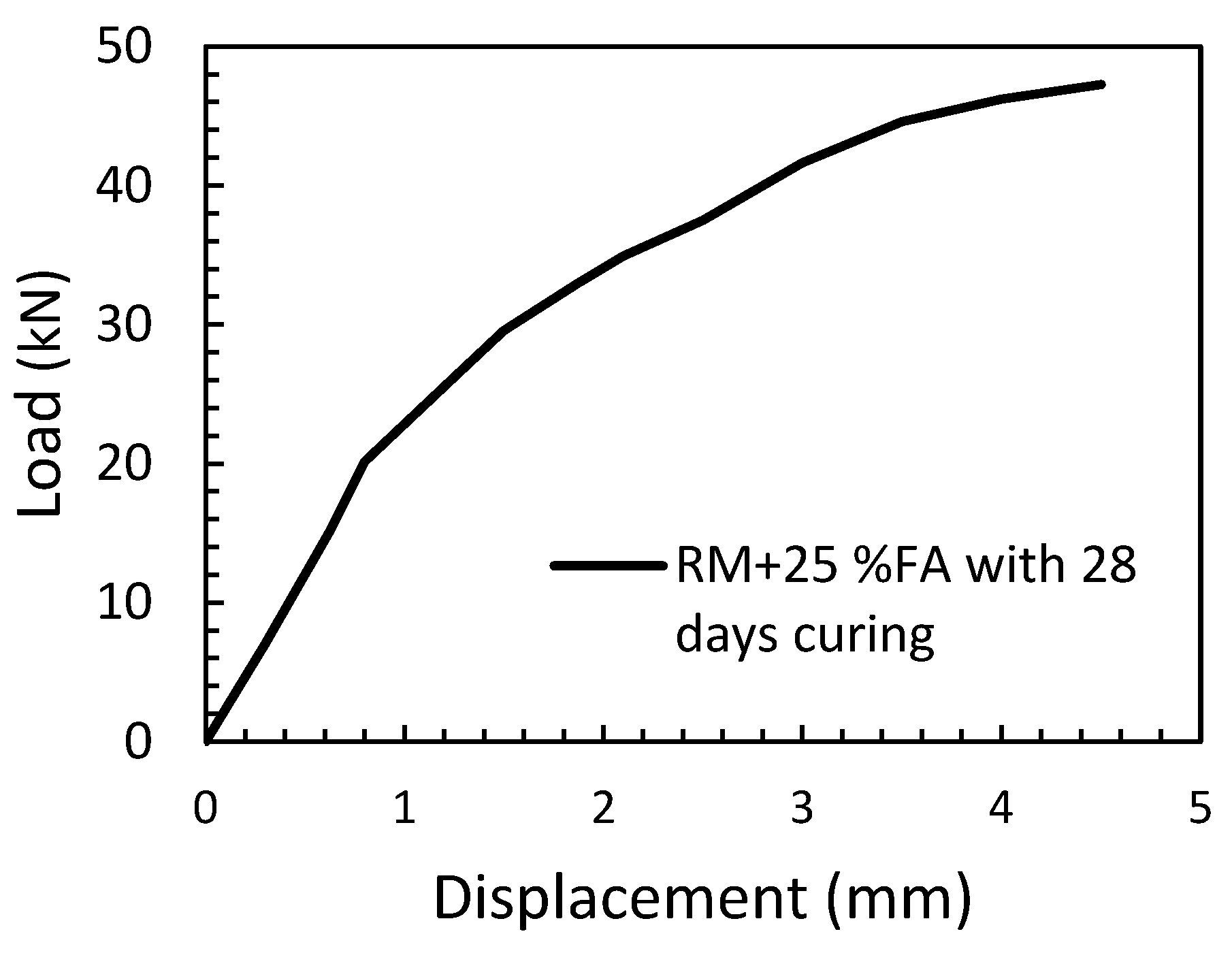
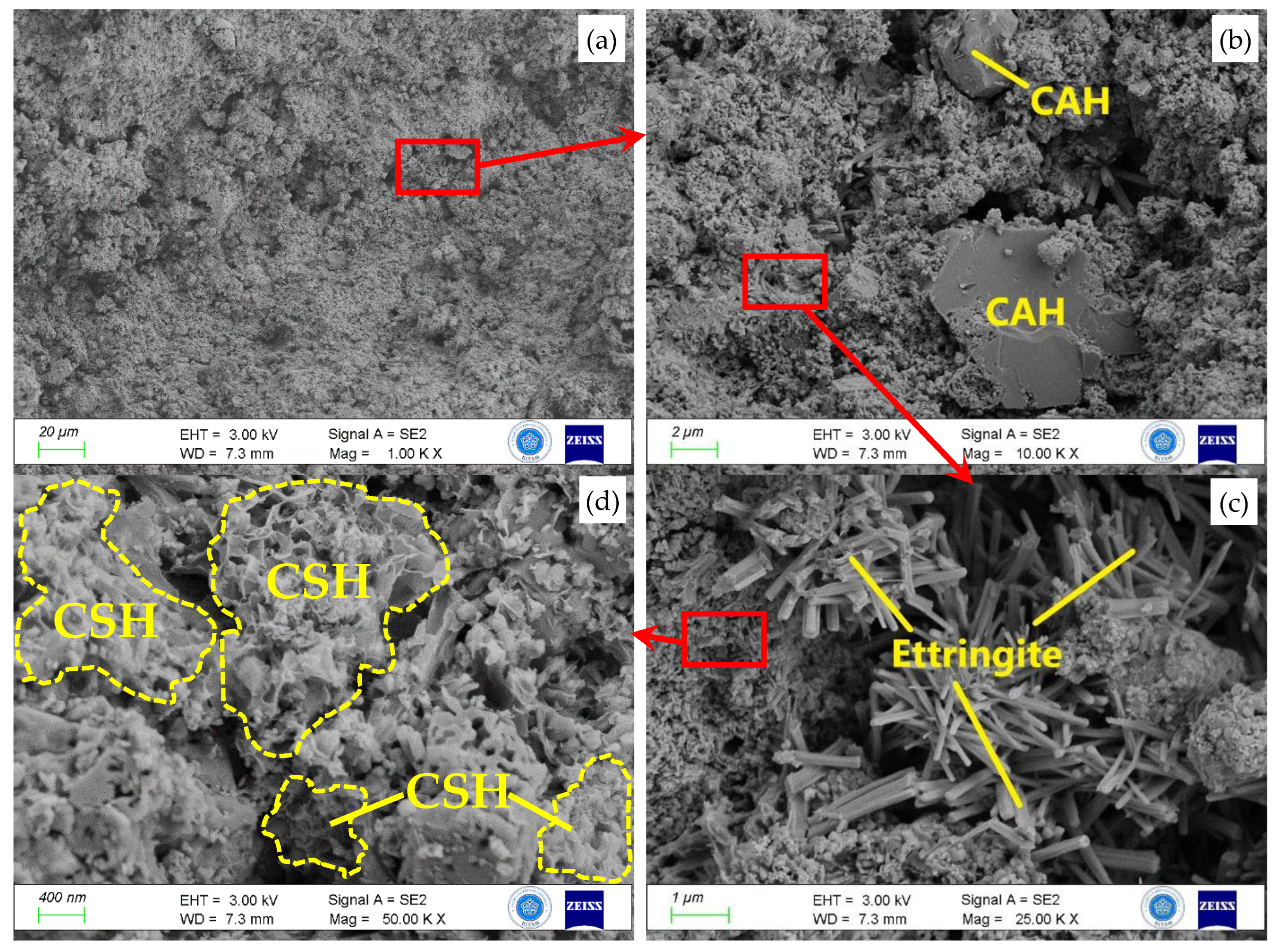
| Property | Value |
|---|---|
| Specific gravity | 2.56 |
| Liquid limit, LL (%) | 40.5 |
| Plastic limit, PL (%) | 37 |
| Plasticity index, PI (%) | 3.5 |
| Soil class (USCS) | ML |
| Optimum moisture content, OMC (%) | 34 |
| Maximum dry density, MDD (g/cm3) | 1.41 |
| Unconfined compressive strength a (kPa) | 220 |
| CBR swell ratio (%) | 1.3 |
| CBR dry (%) | 4.15 |
| CBR wet (%) | 2.85 |
| Material | Al2O3 | SiO2 | Fe2O3 | CaO | Na2O | TiO2 | ZrO2 | SO3 | MgO | K2O |
|---|---|---|---|---|---|---|---|---|---|---|
| RM (%) | 14.30 | 11.40 | 24.10 | 25.10 | 9.35 | 2.95 | 0.44 | 0.28 | 0.22 | 0.11 |
| FA (%) | 5.10 | 15.50 | 8.09 | 41.80 | - | 0.42 | 0.40 | 16.50 | 1.20 | 0.60 |
| Stabilized Specimen | RM (%) | FA (%) |
|---|---|---|
| RM+5% FA | 95 | 5 |
| RM+10% FA | 90 | 10 |
| RM+15% FA | 85 | 15 |
| RM+20% FA | 80 | 20 |
| RM+25% FA | 75 | 25 |
Disclaimer/Publisher’s Note: The statements, opinions and data contained in all publications are solely those of the individual author(s) and contributor(s) and not of MDPI and/or the editor(s). MDPI and/or the editor(s) disclaim responsibility for any injury to people or property resulting from any ideas, methods, instructions or products referred to in the content. |
© 2024 by the authors. Licensee MDPI, Basel, Switzerland. This article is an open access article distributed under the terms and conditions of the Creative Commons Attribution (CC BY) license (https://creativecommons.org/licenses/by/4.0/).
Share and Cite
Soğancı, A.S.; Yenginar, Y.; Özkan, İ.; Güzel, Y.; Özdemir, A. Waste Management of Red Mud and Fly Ash to Utilize in Road Subgrade Material. Sustainability 2024, 16, 2987. https://doi.org/10.3390/su16072987
Soğancı AS, Yenginar Y, Özkan İ, Güzel Y, Özdemir A. Waste Management of Red Mud and Fly Ash to Utilize in Road Subgrade Material. Sustainability. 2024; 16(7):2987. https://doi.org/10.3390/su16072987
Chicago/Turabian StyleSoğancı, Ali Sinan, Yavuz Yenginar, İlyas Özkan, Yusuf Güzel, and Adnan Özdemir. 2024. "Waste Management of Red Mud and Fly Ash to Utilize in Road Subgrade Material" Sustainability 16, no. 7: 2987. https://doi.org/10.3390/su16072987





